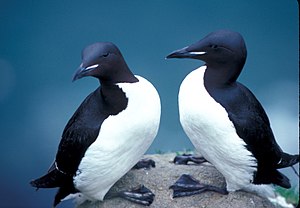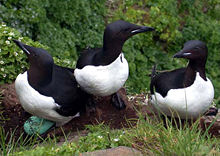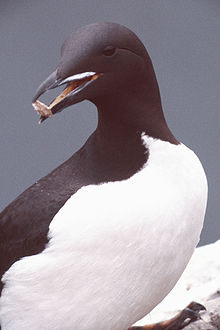Thick beaked mum
| Thick beaked mum | ||||||||||
|---|---|---|---|---|---|---|---|---|---|---|

Thick-billed mummies |
||||||||||
| Systematics | ||||||||||
|
||||||||||
| Scientific name | ||||||||||
| Uria lomvia | ||||||||||
| ( Linnaeus , 1758) |

The thick-billed murre ( Uria lomvia ) is a bird art from the order of Regenpfeiferartigen and the family of the Auks . It occurs in much of northern Asia, North America and Europe. It is a large alkenbird that is a little stronger than the guillemot and has a slightly larger head and thicker neck than this species. On land, the thick-billed mummy either assumes an upright posture or lies on its stomach.
Two recent subspecies are recognized, but genetically they are hardly differentiated.
features
The thick-billed mum is similar to the guillemot in appearance and way of life. The former differs from the latter in the thicker bill with white stripes, the darker, black-brown upper side and the lack of gray dots on the flanks. On average, it is also slightly larger than the guillemot. The black throat plumage extends to the front of the chest, so that a white, inverted V is formed on the two front sides of the body. Like all alken birds, the bird has an elongated body, a short neck and a small head. The wings are relatively small. The feet are long and have three short toes. They can be colored from light red to gray-yellow to green-yellow. The strong beak tapers towards the end. It is slate black and has a white stripe on the upper beak parallel to the cleft mouth. The inside of the mouth and tongue are yellow.
Thick-billed mummies swim very high on the water, the tail is not immersed when swimming. They only fly up with great difficulty and never land on flat ground.
Color and dimensions
In the magnificent dress , the thick-billed mum has a black to black-brown top. The head and neck are also dark in color. The tips of the secondaries are white, the primaries are dark brown. There is a small, featherless furrow behind the eye. The underside to the chest is white like the under tail-coverts.
The plain dress corresponds to the splendid dress, but the neck and head are colored black and white. A white band stretches across the front neck, widening from the center of the neck to the nape of the neck. The lower half of the face and the throat are completely white. Nevertheless, the thick-billed mum is more black on the head than the guillemot.
It becomes 42 to 48 centimeters long, has a wingspan of 75 centimeters and weighs between 750 and 1480 grams.
Flight image
The underside of the wings is two-colored: the edges are translucent and dark brown, while the rest of the plumage on the underside is white. In flight, the thick-billed mum can be distinguished from the guillemot by the lack of black axillary feathers. The bird flaps its wings quickly and is very agile in the air despite the small wings. The flight is straight and vaguely reminiscent of that of a pigeon .
Way of life
Diet and Behavior
The thick-billed mum breed in large colonies on rocky cliffs. There it occurs together with the guillemot, but there are no pairs of both species - let alone mixed forms of both species. The bird needs a lot of run-up on the water to fly ( running flight ). Once in the air, it can fly long distances continuously.
It eats small fish between 5 and 15 centimeters in size, crustaceans (mainly krill ), snails , mussels and squids . The guillemot dives for food from the surface of the water in groups of 20 to 200 birds. It usually swallows its prey underwater.
Reproduction
The mating season of the thick-billed mum begins as soon as it arrives in the breeding areas, i.e. from March to April. The female lays an egg on a ledge in May or June. The almost pear-like shape protects it from rolling away. It is variably spotted on a white to gray or turquoise background. The egg is incubated for 30 to 36 days. The young are fed with small fish that are carried by both partners in their beak. After 18 to 25 days they are lured down the cliff with calls from their parents. They jump down and are slowed down a bit by the wind before they hit the surface of the water. They only reach the ability to fly at the age of one and a half months. The migration to the wintering areas begins as early as July.
Habitat and Distribution
The thick-billed mum breed on cliffs in northern Russia , northern Canada , Alaska , Greenland , Iceland , northern Norway , on the Russian islands, on Svalbard , on the Sea of Okhotsk and on Sakhalin and Hokkaidō .
It is a migratory bird and can travel long distances without a break. Due to its size, it is seldom driven away on the migratory routes, as is the case with crab divers, for example . It is an exception in Mexico , in southern Europe and in inner North America, such as on the Great Lakes . The wintering areas of the birds are in northern and central Europe , Russia, Japan , on the west coast of the USA , on the Labrador Peninsula and on some Atlantic islands such as Newfoundland and the Faroe Islands .
The further north a population breeds, the further north the birds hibernate. According to estimates, around 10,000 to 100,000 of the 350,000 to 400,000 Greenland specimens overwinter on Iceland.
The intensive hunting of adult birds and the collection of eggs has severely harmed this species in Greenland and Newfoundland. In the Russian Barents Sea , hunting is only permitted to residents of local polar stations. Big-billed mummies are very sensitive to marine pollution from oil or gas production systems. They also get stuck in fishing nets and die.
Duration
The population in the North Atlantic was around 6.5 million breeding pairs at the turn of the millennium. The number of Pacific breeding pairs is estimated at 4.5 million.
The European regions with a large population of thick-billed lumbars include Iceland with 341,000 to 861,000 breeding pairs, Svalbard with 850,000 breeding pairs and Greenland with 350,000 to 400,000 breeding pairs. Around 250,000 to 500,000 breeding pairs breed in the north of the European part of Russia. The first successful broods in the north of Norway have been recorded for 1964. There are now 1,000 to 2,000 breeding pairs there.
Subspecies
Three subspecies are recognized, one of which is extinct.
- U. l. lomvia (Linnaeus, 1758) - represents the nominate form - Canada, Russia, Northern Europe
- U. l. arra ( Pallas , 1811) - Canada, Alaska, Russia, Japan
- † U. l. affinis ( Marsh , 1870) - USA in the late Pleistocene , extinct; is considered by some authors as a separate species
Carl von Linné described the thick-billed mum in 1758 as Alca lomvia .
The following two subspecies, which were previously also delimited, are no longer recognized as subspecies today. The distinction was based solely on minimal color differences.
- U. l. Heckeri Portenko, 1944 - Russia
- U. l. eleonorae Portenko, 1937 - Russia
supporting documents
literature
- Peter H. Barthel, Paschalis Dougalis: What is flying there? The classic. (All bird species in Europe in 1700 color images). Kosmos, Stuttgart 2006, ISBN 3-440-09977-6 .
- Hans-Günther Bauer, Einhard Bezzel , Wolfgang Fiedler (Hrsg.): The compendium of birds of Central Europe. Everything about biology, endangerment and protection. Volume 1: Nonpasseriformes - non-sparrow birds. 2nd, completely revised edition. Aula-Verlag, Wiebelsheim 2005, ISBN 3-89104-647-2 .
- Anthony J. Gaston, Ian L. Jones: The Auks (= Bird Families of the World. Vol. 4 (recte 5)). Oxford University Press, Oxford et al. 1998, ISBN 0-19-854032-9 .
- Bernhard Grzimek : Grzimeks animal life. Deutscher Taschenbuch Verlag GmbH & Co.KG, Munich 1968.
Web links
- Current discussion about the extension of the hunting period in view of the sharply decreasing numbers of breeding pairs
- Uria lomvia in the endangered Red List species the IUCN 2008. Posted by: BirdLife International, 2008. Accessed on December 22 of 2008.
- Videos, photos and sound recordings of Uria lomvia in the Internet Bird Collection
- Birdlife international
- Avibase
- Feathers of the thick-billed mum




